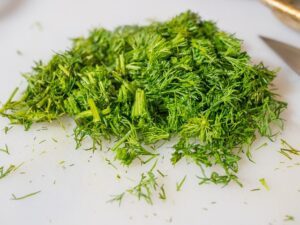
Learn everything you need to know about how to grow dill from seed to harvest. Our comprehensive guide covers planting, care, and uses for this versatile herb.
Introduction
Dill is a beloved herb known for its aromatic properties and versatility in both culinary and medicinal applications. Whether you’re sprinkling it over salmon or using it as a digestive aid, dill can add a fresh touch to various dishes and health remedies. Growing your own dill is not only rewarding but also provides an endless supply of fresh leaves and seeds for your kitchen and wellness needs.
Understanding Dill Basics
Botanical Description
Dill, scientifically known as Anethum graveolens, is a herbaceous plant with feathery green leaves. It belongs to the celery family, Apiaceae.
Types of Dill Varieties
Popular varieties include ‘Fernleaf’, ‘Hera’, and ‘Bouquet’. Each type varies in size and flavor.
Annual or Perennial Characteristics
Dill is typically grown as an annual, although it can self-seed and return in some climates.
Native Habitat and Growing Zones
Native to the Mediterranean and Russia, dill thrives in USDA zones 3-7.
Choosing the Right Location
Dill Sunlight Requirements
Dill requires full sun to produce the best flavor, requiring at least 6 to 8 hours of sunlight daily.
Best Soil Conditions for Growing Dill
Ideal soil should be well-draining, rich in organic matter, and light.
Dill Plant Ideal Soil pH
Aim for a soil pH between 6.0 and 7.5 for optimal growth.
Dill Plant Spacing Considerations
Space dill plants around 12 inches apart to allow for their feathery growth.
Dill Seed Companion Planting Recommendations
Dill grows well with cabbage, onions, and lettuce but avoid planting it near carrots and cilantro due to cross compatibility.
Planting Dill
When to Plant Dill Seed (Seasonal Guidelines)
Plant dill in spring, a few weeks before the last frost. You can also plant in late summer for a fall harvest.
Dill Seed Selection
Choose seeds from reputable suppliers to ensure viability.
Direct Sowing vs. Transplanting Dill Seed
While direct sowing is preferred, you can transplant dill with care, ensuring minimal root disturbance.
Dill Seed Depth and Germination Tips
Sow seeds about 1/4 inch deep. Maintain consistent moisture until seeds germinate, usually within 10-14 days.
When to Start Dill Seed Indoors
Dill can be started indoors 4-6 weeks before the last frost date in your area.
Harvesting Dill
How to Know When Dill is Ready to Harvest
Harvest dill when it reaches around 3-4 inches tall and before the flowers bloom.
Dill Plant Spacing Between Plants
Keep plants spaced about 12 to 18 inches apart for optimal air circulation.
Soil Preparation and Nutrition
Best Soil Composition for Dill
A sandy-loam soil complements dill well.
Organic Matter and Compost
Mix in well-rotted compost to improve soil nutrition.
Dill Fertilization Needs
Feed with a balanced organic fertilizer once during the growing season.
Dill Mulching Techniques
Apply a layer of organic mulch to retain moisture and suppress weeds.
Dill Watering and Maintenance
Optimal Watering Schedule
Maintain moderate soil moisture, allowing the top inch of soil to dry out between watering.
Moisture Requirements
Ensure consistent moisture for lush foliage, but avoid waterlogging.
How often should I water? Water when the soil is dry to the touch, usually every 2-3 days.
Pruning Dill
Prune dill regularly to promote bushier growth and prevent it from going to seed too quickly.
Drought Tolerance
While somewhat drought-tolerant once established, dill prefers regular watering.
Preventing Overwatering
Ensure well-drained soil and use mulch to prevent waterlogging.
Dill Pest and Disease Management
Common Pests Affecting Dill
Watch out for aphids and caterpillars.
Organic Pest Control Methods for Dill
Use neem oil or insecticidal soap to manage pests organically.
Dill Disease Prevention
Ensure good air circulation around plants to prevent fungal diseases.
Beneficial Insects
Attract beneficial insects like ladybugs that naturally control pest populations.
Harvesting Dill
When to Harvest Dill
Harvest leaves once the plant reaches about 8 inches in height; seeds should be collected when umbels turn brown.
Harvesting Techniques for Leaves
Snip leaves just above a leaf node to encourage regrowth.
Collecting Dill Seeds
Cut seed heads when they are brown, dry them in a paper bag, and store the seeds for planting or culinary use.
Proper Storage Methods
Store fresh dill leaves in a sealed bag in the refrigerator for up to a week.
Preserving and Using Dill
Drying Techniques
Air dry leaves or use a dehydrator for long-term storage.
Freezing Methods
Freeze dill leaves in ice cube trays with water for later use in soups and stews.
Culinary Uses
Use in salads, pickles, fish dishes, and sauces.
Medicinal and Health Benefits
Dill is known to aid in digestion and may offer anti-inflammatory benefits.
Troubleshooting Common Growing Issues
Dill Bolting Prevention
Provide consistent moisture and cooler conditions to prevent premature flowering.
Dealing with Pest Infestations
Regular inspections and organic controls keep pest numbers down.
Dill Nutrient Deficiency Signs
Yellowing leaves may indicate nutrient deficiencies; address with appropriate fertilizers.
Reviving Struggling Plants
Ensure adequate water, light, and soil conditions if plants are underperforming.
Growing Dill in Raised Beds
Raised beds provide better drainage and temperature control for dill plants. The planting instructions are the same.
Growing Dill in Pots
Choose a deep pot with drainage holes; keep soil consistently moist. Pot will need to be moved indoors in colder climates before frost.
The ideal depth for a dill pot is at least 10 inches, with a width of around 12 inches. This will provide enough room for the roots to grow and allow the plant to reach its full potential. Make sure to also choose a pot that has good drainage to prevent waterlogging and root rot.
When growing dill in pots, it’s important to keep the soil consistently moist but not overwatered. Check the moisture level regularly and water when the top inch of soil feels dry. Adding mulch on top of the soil can help retain moisture and regulate soil temperature.
Growing Dill Hydroponically
Dill can also be grown hydroponically, which is a method of growing plants without soil. This involves using nutrient-rich water as the growing medium and a controlled environment to provide optimal conditions for growth.
To grow dill hydroponically, you will need a container or tray with holes for drainage, a nutrient solution, and a light source such as LED lights. Follow the instructions on your hydroponic system for mixing and adding the nutrient solution. Place seeds or seedlings in the holes and keep them under the lights for 14-16 hours per day.
Hydroponically grown dill may grow faster than those planted in soil and may have a stronger flavor due to increased nutrients. However, it’s important to regularly check the pH levels of the nutrient solution to ensure optimal growth.
How long will hydroponic dill continue to grow? It can continue to grow and produce leaves for several months, as long as the growing conditions and nutrients are maintained. After several months, dill plants may start to decline in growth and flavor.
Are there any dwarf dill cultivars for hydroponics? Yes, there are dwarf cultivars of dill that are suitable for hydroponic growth, such as ‘Fernleaf’ and ‘Dukat’. These varieties are more compact and have a shorter harvest time, making them ideal for small growing spaces.
Conclusion
Growing your own dill is a fulfilling activity that enhances your culinary repertoire while providing medicinal benefits. By following this guide, you’ll enjoy fresh, homegrown dill ready to elevate your dishes and aid in health. Happy gardening, and relish the benefits of nurturing this exquisite herb in your own backyard!
